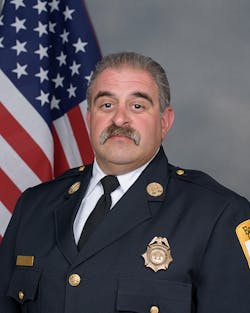Disclaimer: Check your feelings at the door. That’s how Captain Dan Maffia of the City of Fayetteville, NC, Fire & Emergency Management prefaced his Thursday Firehouse World session “Taboos in the Fire Service: The Things We Don’t Want to Talk About.” Maffia’s session explores a variety of topics that many in the fire service are afraid to address—women and minorities, pranks and hazing, PTSD, mental health, stress, relationships between coworkers, substance abuse, gay and transgender individuals in the fire service, clinging to dangerous traditions and resistance to change and technology.
In an interview before the conference, Maffia explained that he had the idea for the session while attending a leadership class at the National Fire Academy. “The instructor said that being a leader means that you have to talk about things you don’t want to talk about,” he said. From there, Maffia started thinking about how many things members of the fire service simply avoiding talking about. He later developed the Firehouse World session with the goal of encouraging firefighters to talk about these topics, determine why these issues feel so uncomfortable to confront and, ultimately, promote a culture that fosters an open dialogue.
Women and minorities
No one would argue that firefighting has always been an industry dominated by white men. Women and minorities joining the ranks has been a point of discussion and debate for decades. But why is this still a cause of discomfort? Maffia explained that part of the reason comes down to the numbers, highlighting that women, for example, make up only about 4 percent of career firefighters. So even though acceptance is growing, the numbers aren’t exactly skyrocketing—and this can lead to a natural separation.
But it is this separation that Maffia sees as a problem. “Some of this is our own fault,” he said. “We find ways to separate ourselves within the umbrella of the fire service.” As an example, Maffia explained that we have different organizations, fraternal or social, for specific demographics. He noted that these separate organizations or associations were certainly needed at one time to advance or advocate for a specific cause or subculture within the fire service, but questions whether this separation is still necessary and if it actually fosters a culture of division.
Related to the issue of women in the fire service, Maffia referenced a friend of his who is a high-ranking career firefighter—and a woman. She has shared with him that she joined the fire service knowing full well that it was a male-dominated profession, and that she would not want to be a part of an organization that seeks for preferential treatment, or really any kind of different treatment, because she knows that she has to do her job just like the men. Maffia noted that there are of course situations where separation must be managed, like with living accommodations at the firehouse, “But when the tones drop and the crew shows up to a working fire, the fire does not know the difference between a man and a woman.”
Behavioral health: PTSD, suicide, stress
Maffia acknowledged that behavioral health issues related to PTSD, suicide and stress are finally getting much more attention than in decades past, partly because the fire service publications and media are bringing the issues to the forefront on a more consistent basis. But there’s more to do to ensure that people feel they have the support they need, particularly because of how the fire service has historically handled these issues.
“For the longest time, it was ‘suck it up, princess, it’s a tough job.’ You don’t cry. You deal with it and move on. That was it,” Maffia explained. “It’s taken 25-plus years to finally realize that doesn’t work.” But the things firefighters see and handle build up over time and wear on their mental well-being. Further, he says, there’s a different generation of firefighters coming into the fire service, and they handle these stressors in a different manner.
Maffia noted that the statistics support the continued need to address behavioral health issues. In his research, he learned that 31 percent of veterans from the recent wars in Afghanistan and Iraq exhibited signs of PTSD. What’s startling, he said, is that an even higher percentage—37 percent—of fire and EMS personnel exhibit signs of PTSD. “We know the sacrifices that combat soldiers make. We owe them a debt for their sacrifices for their country. But people don’t realize the sacrifices that first responders make.”
Supporting behavioral health issues must be a priority, Maffia said, and it starts at the top: “It takes some bold and aggressive leaders, national names in the fire service like the John Salkas, Billy Goldfeders and Tim Sendelbachs to say that asking for help is not a bad thing that we are all human.” He added that the responsibility really falls on everyone involved, though. Specifically, the company officer must look out for the health and wellness of their personnel. They must know the signs and symptoms of stress, and step in if they see issues, like a crewmember having difficulty getting along with others, and sit down and talk to them. It’s also up to the person who is experiencing a problem to seek help and investigate the many resources that are available to them, including their department’s EAP or a peer support group.
Experience, change and adaptation
Maffia explained that another topic that seems to make some people uncomfortable is the decrease in experience levels. With improved fire prevention efforts, the number of fires has decreased, which is great for property loss and fire fatalities, but not great for honing real-world fireground skills. Today’s fire officers simply don’t have the same experience to then pass on to the next generation, he said, “And conversely, 50 years ago, officers wouldn’t have imagined responding to some of the incidents we do today—hazmat, technical rescue and others.” Maffia noted that we’re coming to a transition point where we’re shifting from story-telling about real events to recollecting events that we didn’t experience ourselves. “That is a huge change in the culture of the fire service,” he said.
And adding to the culture change is the significant advances in technology over the past decade—and some firefighters’ resistance to accept a new way of operating. Maffia explained that more than half of fire personnel are 40 years of age or older. “We weren’t raised on a lot of this technology,” he said. “We did reports by hand. We had to learn how to use the new technology.” But still, some resist the shift, insisting that the “old ways” (e.g, run cards, fold-out maps) get the job done.
Maffia explained that the key is acknowledging that different generations approach learning in different ways. “When I’m teaching a cross-generational class, I show them the benefits of everything—it’s ‘Here’s what we’ve done in the past and here’s the new way. You decide for yourself.’” He added that fire personnel must be open-minded and not automatically take the “this is how I’ve always done it” approach, regardless if that’s a newer or older method.
Final thoughts
So what can someone do if they want to talk about a potentially sensitive topic but aren’t sure who they can trust? Maffia reiterated that there are many resources available for addressing any of the topics from his session, including online resources, a department’s EAP and other firefighters. He said he hopes that session attendees will share how they have dealt with some of these issues and even interact to build a network of people they can talk to.
Maffia explained that many of these “taboo” topics boil down to a simple philosophy: “At the end of the day, fire doesn’t know the difference between a man and a woman, a black firefighter or a white firefighter, a gay firefighter or a straight firefighter, the list goes on. What matters is that they can do the job.” And for the people who have a harder time accepting some of the changes that are happening in the fire service, Maffia suggested that they try to remember why they joined the fire service—to serve the citizens of the community. “You don’t get to choose who you serve, and you can’t choose who you serve with as well.”
About the Author

Janelle Foskett
Janelle Foskett served as editorial director of Firehouse Magazine and Firehouse.com, overseeing the editorial operations for the print edition along with working closely with the Web team.
